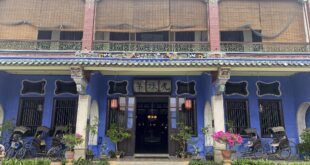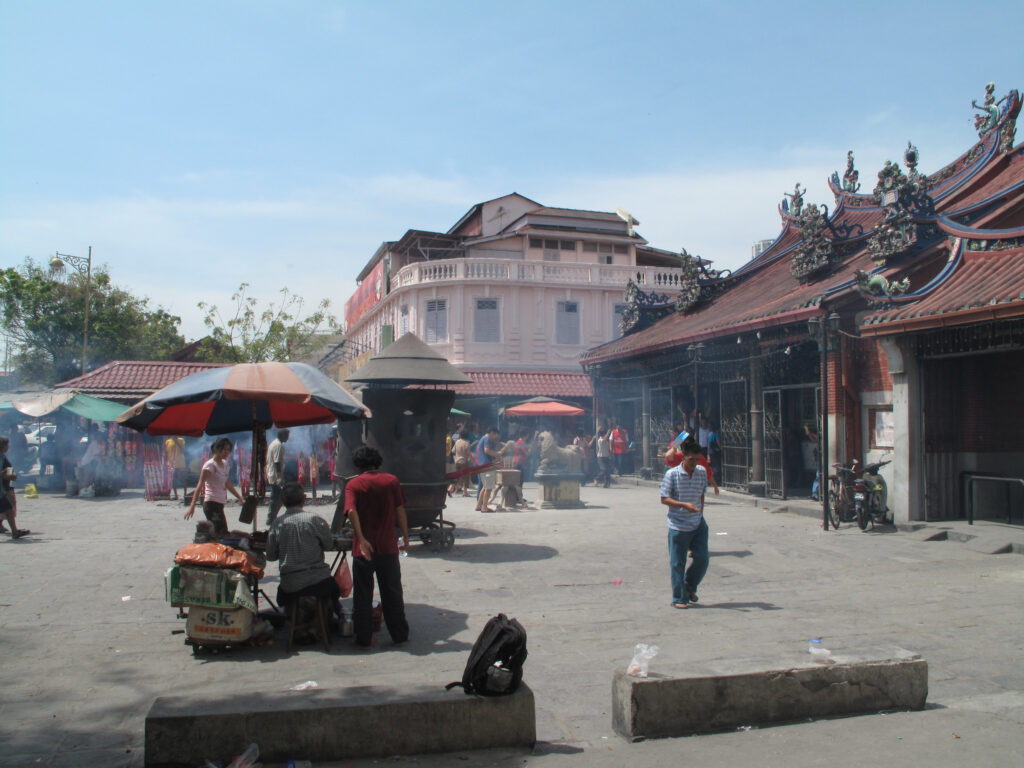
Located in the heart of George Town, Penang, the Kuan Yin Temple is a cherished landmark that offers a blend of historical, cultural, and spiritual significance. Known as one of the oldest temples in Penang, it stands as a testament to the resilience and faith of early Chinese settlers.1
Revered for its spiritual significance, this temple has been a sanctuary of hope, prayer, and prosperity for centuries. Here are seven intriguing secrets about the Kuan Yin Temple that make it a must-visit for anyone exploring Penang heritage landmarks.
Table of Contents
The Strategic Location Rooted in Feng Shui
The location of the Kuan Yin Temple was meticulously chosen, reflecting the profound knowledge and spiritual vision of early Chinese settlers. Perched on a naturally elevated knoll surrounded by the marshlands of early Penang, this site was seen as a harmonious meeting point of earth, water, and wind—key elements in feng shui principles. This positioning was not only practical for protection against flooding but also symbolized an ideal flow of positive energy, or chi, through the landscape.
The “green dragon energy,” an auspicious force believed to emanate from such strategic alignments, was thought to create an invisible shield of prosperity and protection. This energy flow was seen as particularly crucial for seafarers, who viewed the temple as a spiritual anchor before embarking on or returning from treacherous journeys. The surrounding hills were interpreted as protective arms cradling the temple, while the nearby sea offered an open channel for wealth and opportunities to flow.
Beyond its spiritual foundation, the site also held immense cultural and psychological significance for the early Chinese community. By building the Kuan Yin Temple at this carefully selected spot, the settlers created not just a place of worship but a symbol of their identity and connection to their homeland’s traditions.
This spiritual significance of Kuan Yin Temple continues to resonate with visitors, blending centuries-old wisdom with a timeless message of harmony between humanity and the environment. This enduring legacy makes the temple not only a historical landmark but also a living reminder of the powerful interplay between nature, belief, and community.
The Hidden Treasure Beneath the Temple
Beneath the Kuan Yin Temple lies a natural phenomenon that transcends its historical and spiritual value which are three freshwater springs that were vital to both life and trade in early Penang. These springs, regarded as “hidden blessings,” were not just a physical resource but also held symbolic meaning for the sailors and settlers who relied on them. The life-sustaining water represented renewal, prosperity, and divine care, reinforcing the temple’s status as a sanctuary of hope.
During the early maritime era, when long voyages meant enduring harsh conditions and limited access to fresh supplies, these springs were a beacon for survival. Sailors navigating the unpredictable Malacca Straits often stopped near the temple to replenish their water stores, making it a critical waypoint on the maritime map. The availability of fresh water not only addressed the physical challenges of scurvy and dehydration but also provided psychological comfort to seafarers who saw these springs as a divine gift, safeguarded by the spiritual aura of the temple.
The springs also played a subtle yet important role in establishing the spiritual significance of Kuan Yin Temple. Many early travelers believed that the water carried sacred blessings, as its presence beneath such a spiritually charged site was seen as no coincidence. Rituals involving the water became a common practice, with sailors offering prayers of gratitude before continuing their journeys.
The presence of these hidden springs remains a cornerstone of Kuan Yin Temple history, symbolizing the temple’s role as a place of both practical and spiritual nourishment. They serve as a reminder of the deep interconnection between natural resources, human survival, and faith, highlighting the temple’s multifaceted importance in the region’s development and heritage.
A Maritime Haven for Early Sailors
The Kuan Yin Temple was more than a spiritual sanctuary, it was a vital landmark for sailors braving the harsh realities of maritime travel in the Malacca Straits. Positioned at a strategic crossroads of major trade routes, the temple became an integral part of the early sailors’ survival and spiritual practices. For these travelers, who often faced unpredictable weather, treacherous waters, and months of isolation, the temple represented a beacon of safety and hope.
Unlike mere physical waypoints, the temple offered a unique blend of practical and spiritual solace. Upon reaching Penang, sailors from China, Arabia, and India would not only replenish their provisions and water but also seek blessings for a safe onward journey. This practice involved leaving offerings such as incense, food, or symbolic items, reflecting deeply ingrained religious practices in George Town. Such rituals were believed to invoke the protection of divine forces, especially Kuan Yin, the Goddess of Mercy, known for her compassion and ability to avert misfortune.
The temple’s location near the coastline and freshwater springs further enhanced its appeal. It wasn’t just a pit stop but a place where weary sailors could rest and rejuvenate their spirits before embarking on their next leg of the journey. Stories of miraculous rescues and successful voyages attributed to prayers offered at the temple only added to its reputation, drawing more sailors and traders to its doors.
As maritime activity flourished, the spiritual significance of Kuan Yin Temple grew. Its presence became synonymous with the idea of safe passage and prosperity, weaving it into the fabric of Penang’s bustling trade networks. Today, the temple stands as a testament to Penang’s multicultural and maritime heritage, reminding visitors of the pivotal role it played in connecting not just people and goods but also faith and resilience.
Admiral Cheng Ho’s Legendary Footprint
The story of Admiral Cheng Ho, the renowned Chinese diplomat, explorer, and mariner of the Ming Dynasty, adds a fascinating dimension to the Kuan Yin Temple history. Known for leading one of the largest fleets in maritime history, Admiral Cheng Ho’s voyages not only advanced Chinese trade but also fostered cultural and diplomatic ties across Asia and beyond. It is said that during one of his 15th-century expeditions, Cheng Ho and his fleet made a pivotal stop in Penang.
Attracted by the island’s strategic location and its life-sustaining freshwater springs, Cheng Ho is believed to have chosen the site near the present-day Kuan Yin Temple as a resting and resupply point for his crew. These freshwater springs, often referred to as “mariner’s gold,” were critical for sustaining his fleet on their long journeys. This practical reliance on Penang’s natural resources not only contributed to its maritime significance but also intertwined the temple’s location with Cheng Ho’s storied legacy.
Adding an air of mystique, local legend claims that Cheng Ho left an indelible mark during his visit—a footprint embedded in a rock at Batu Maung, a site that continues to be revered to this day. While historians debate the factual accuracy of the tale, the symbolic association with Cheng Ho elevates the temple’s cultural and historical significance. The footprint is often interpreted as a testament to his impactful presence and the profound connection between Penang’s maritime heritage and its spiritual landmarks.
Beyond the legend, the temple and its connection to Cheng Ho represent the blending of practical needs with spiritual devotion. Cheng Ho’s voyages were not solely about trade; they also involved fostering goodwill, spreading Chinese cultural influence, and building alliances. The spiritual significance of Kuan Yin Temple, a place devoted to Kuan Yin, the Goddess of Mercy, would have resonated deeply with Cheng Ho and his crew, providing a source of spiritual strength during their perilous journeys.
The story of Admiral Cheng Ho’s footprint at Batu Maung and his link to Kuan Yin Temple serves as a captivating narrative that enriches Penang’s heritage. It symbolizes the island’s role as a hub of connection—not just for trade and navigation but also for cultural exchange and spiritual solace. This enduring legend continues to draw visitors, inspiring them to explore the layers of history and belief tied to this remarkable figure and the temple he is said to have visited.2
Transformation Over Time: From Wells to Worship
The journey of the Kuan Yin Temple from a practical waypoint to a revered spiritual sanctuary is a testament to its adaptability and significance. Initially celebrated for its three freshwater springs, which provided vital sustenance to sailors and early settlers, the site quickly evolved into a focal point for cultural and religious expression. These life-giving springs were not just a natural resource but a symbol of divine favor, inspiring the first steps toward transforming the location into a sacred space.
In its earliest days, the temple was dedicated to Ma Chor Po, the patron deity of sailors, reflecting the needs of the maritime community. Seafarers, dependent on safe passage and favorable conditions, flocked to the temple to offer prayers and seek protection.3 The dedication to Ma Chor Po mirrored the practical focus of the temple, rooted in its role as a guardian for those navigating the Malacca Straits.
As George Town grew and diversified, so did its spiritual needs. Over time, the temple was rededicated to Kuan Yin, the Goddess of Mercy, embodying compassion, hope, and forgiveness. This transformation reflected the shifting priorities of the local Chinese community, who sought solace not just for physical survival but for emotional and spiritual well-being. The transition also symbolizes the evolving religious practices in George Town, as the temple became a sanctuary for individuals from all walks of life, extending its reach beyond sailors to families, traders, and pilgrims.
The temple’s architecture and rituals also transformed to align with its new purpose. Traditional Chinese elements, such as intricate carvings and sacred altars, were introduced to enhance its spiritual ambiance. These changes enriched the Kuan Yin Temple history, turning it into a cherished hub for religious ceremonies and festivals, including the annual Nine Emperor Gods Festival and Lunar New Year celebrations.
The spiritual significance of Kuan Yin Temple lies in its ability to adapt and serve the community’s changing needs while preserving its historical roots. The temple stands as a symbol of resilience and unity, bridging its origins as a place of survival to its current status as a sanctuary of hope and worship. This evolution captures the essence of George Town’s dynamic heritage, where tradition and transformation coexist seamlessly.
The Mystical Hillock and Its Protective Energy
The hillock on which the Kuan Yin Temple stands has been a source of fascination and reverence for centuries, not just for its geographical prominence but for the mystical energy it is believed to hold. Early Chinese settlers and sailors saw this elevated land as a site infused with powerful protective forces. Its natural rise above the surrounding lowlands was interpreted as a safeguard, both physical and spiritual, against the hardships of life in an unfamiliar land.
This small hill was believed to radiate energy that warded off not only tangible threats like scurvy and tropical diseases but also unseen dangers, such as malevolent spirits or supernatural forces. These beliefs were deeply ingrained in the spiritual traditions of the time, where natural features like hills and springs were often associated with divine protection. For sailors who risked their lives in unpredictable seas, the hillock provided a sense of security and reassurance, making the spiritual significance of Kuan Yin Temple even more profound.
The temple’s location on this mystical hill also aligns with feng shui principles, further solidifying its reputation as a place of balance and harmony. The site’s proximity to natural elements, such as the hills in the background and the sea in the distance, reinforced the belief that it was under the guardianship of powerful cosmic forces. This harmony was seen as essential for the well-being of those who sought refuge or blessings there.
In addition to its spiritual role, the hillock played a practical part in the survival of early settlers. Its elevation protected the temple and its visitors from flooding, a frequent challenge in Penang’s early days. Over time, the hill came to symbolize resilience and endurance, mirroring the challenges and triumphs of the community it served.
The Kuan Yin Temple history is inextricably linked to this hillock and its enduring mystical energy. Visitors continue to experience a sense of peace and connection when they step onto this sacred ground. Whether they come seeking blessings, solace, or simply to marvel at the temple’s rich heritage, they are part of a tradition that has cherished the protective energy of this hill for generations. This legacy makes the temple not only a spiritual landmark but also a cornerstone of Penang’s cultural identity.
A Cultural and Spiritual Hub for Generations
Since its construction in 1800, the Kuan Yin Temple has evolved into far more than a place of worship—it is a cornerstone of Penang’s identity and a beacon of cultural harmony. Nestled in the heart of George Town, the temple has witnessed the rise and transformation of the city, standing resilient through wars, colonization, and modernization. Its enduring presence symbolizes the unwavering faith of the local Chinese community and their deep-rooted traditions.
The temple remains a focal point for a variety of ceremonies and festivals, from the colorful Lunar New Year celebrations to the spiritually significant Nine Emperor Gods Festival. During these events, the temple grounds come alive with devotees performing intricate rituals, offering prayers, and burning incense. These practices not only highlight the spiritual significance of Kuan Yin Temple but also preserve the cultural heritage passed down through generations.
Beyond its religious activities, the Kuan Yin Temple history reflects its role as a gathering place for the community. In its early days, it served as a center for Chinese immigrants who sought not only spiritual guidance but also social connection and support. Over time, the temple became a unifying space where diverse traditions and beliefs could coexist, exemplifying the multicultural fabric of Penang.
Visitors to the temple today experience a sensory journey: the rhythmic chanting of prayers, the flickering light of red lanterns, and the soothing aroma of incense create a serene yet vibrant atmosphere. These timeless elements bridge the gap between the past and present, allowing modern audiences to connect with traditions that have shaped the lives of countless generations.
As one of the most iconic Penang heritage landmarks, the temple continues to inspire and attract people from all walks of life. Its ability to adapt while preserving its essence makes it a symbol of resilience and continuity, showcasing how spirituality and culture can thrive together. For locals and tourists alike, the Kuan Yin Temple offers not only a glimpse into the spiritual life of George Town’s Chinese community but also a deeper understanding of Penang’s rich and dynamic history.
Final Thoughts
The Kuan Yin Temple’s role as a maritime haven extended beyond its practical offerings of freshwater; it was a beacon of hope and protection for sailors navigating the unpredictable seas. Traders from China, Arabia, and India, drawn to Penang’s shores, embraced the temple as a sacred space where they could perform rituals and leave offerings to deities for safe passage.
These customs exemplify the deeply rooted religious practices in George Town, reflecting the sailors’ reliance on spiritual support during their perilous journeys. The temple’s dual role as a logistical hub and a spiritual sanctuary solidified its position as a cornerstone of Penang’s rich maritime heritage.
Remarkable Journey Through Time From Construction To Today
1800s – The Beginning Of A Sacred Space
- The Kuan Yin Temple was constructed by early Chinese settlers in 1800 as a place of worship, reflecting their devotion to Kuan Yin, the Goddess of Mercy.
Mid-1800s – A Beacon For Sailors And Traders
- The temple became a crucial landmark for sailors and traders in Penang, offering not just spiritual solace but access to life-saving freshwater springs.
1900s – Growth As A Community Hub
- The temple saw an influx of worshippers and visitors, establishing itself as a key center for religious and cultural activities in George Town.
1940s – A Shelter During The War
- During World War II, the temple provided refuge to locals seeking safety, cementing its role as a sanctuary in times of crisis.
1970s – A Site For Festive Celebrations
- The temple became a focal point for Chinese festivals, such as the Lunar New Year and the Nine Emperor Gods Festival, drawing devotees from across Penang.
1990s – Preservation Of A Cultural Treasure
- Recognized as one of Penang’s most iconic heritage landmarks, efforts were initiated to restore and preserve the temple’s historic architecture and significance.
2008 – Recognition As A UNESCO World Heritage Site
- As part of George Town, the Kuan Yin Temple contributed to the city’s designation as a UNESCO World Heritage Site, celebrating its cultural and historical value.
2020s – A Living Legacy Of Hope And Faith
- Today, the temple remains a vibrant place of worship and a symbol of Penang’s multicultural heritage, attracting visitors from all over the world.
FAQ
What are the visiting hours for Kuan Yin Temple?
The temple is typically open daily from 7:00 AM to 5:00 PM. However, it is recommended to check for any changes during public holidays or special festivals.
What is the best time to visit Kuan Yin Temple?
Early mornings are ideal for visiting the temple as it is less crowded, and the atmosphere is peaceful. Visiting during Chinese festivals can also offer a unique cultural experience, but it may be busier.
Is there an entrance fee for Kuan Yin Temple?
Entrance to the Kuan Yin Temple is free, but donations are welcome to help maintain the temple and its activities.
Nearby Attractions to Explore
Pinang Peranakan Mansion
A beautifully restored mansion showcasing the opulent lifestyle and culture of the Peranakan community. It’s a treasure trove of antiques and intricate architecture.
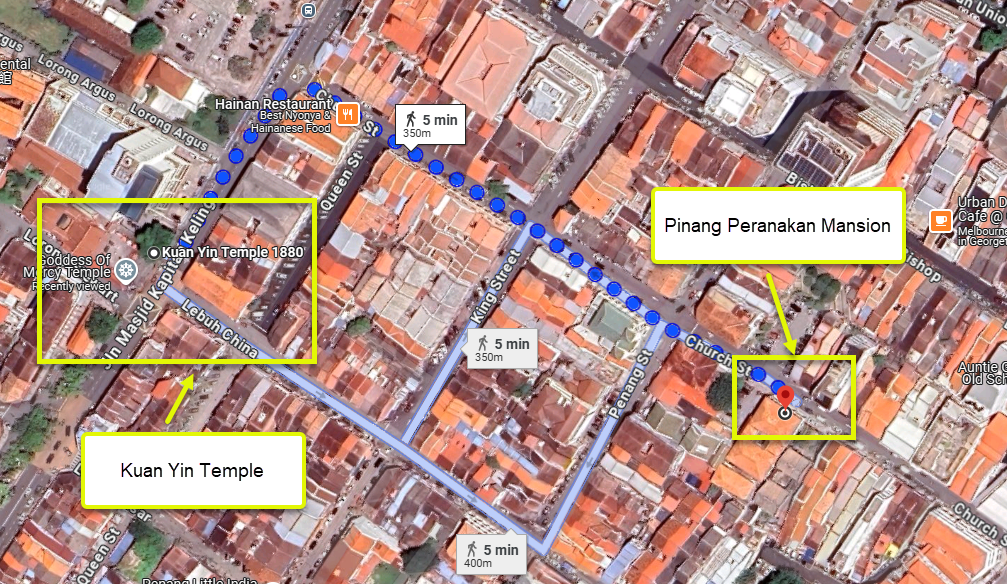
Armenian Street
A vibrant street filled with street art, quaint cafes, and boutique shops. It’s a hotspot for exploring Penang’s cultural heritage and contemporary creativity.
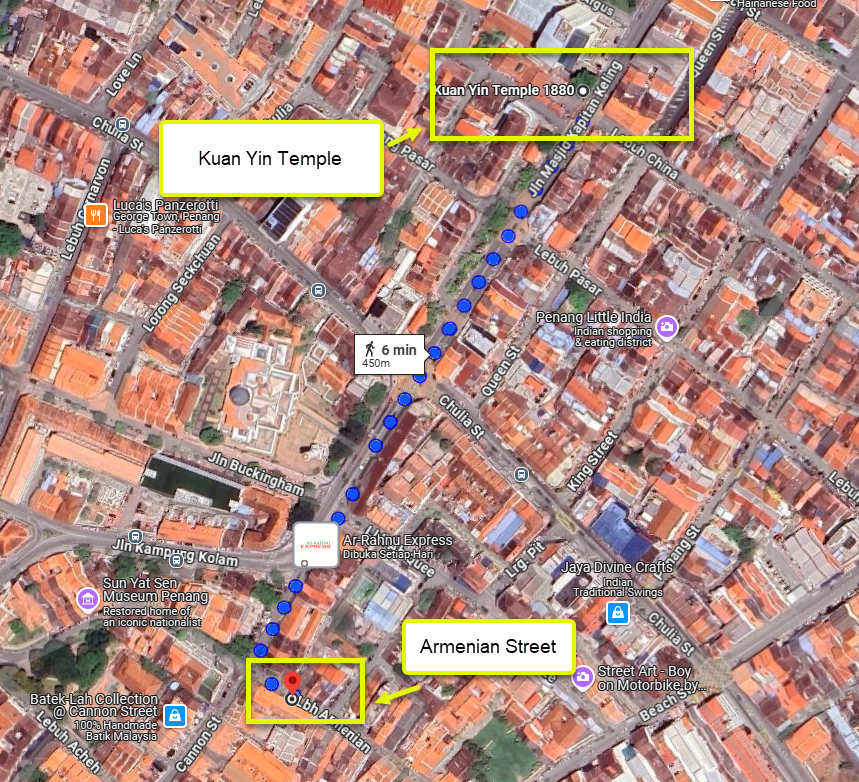
Cheong Fatt Tze Mansion (The Blue Mansion)
A UNESCO-awarded heritage building known for its stunning indigo facade, intricate design, and rich history.
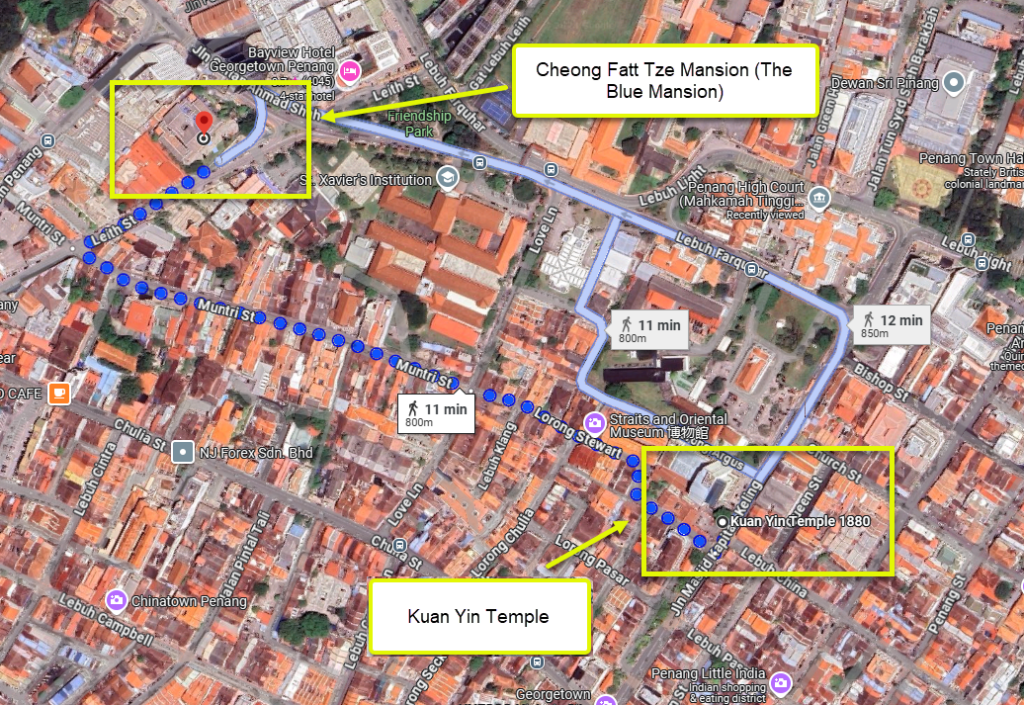
Kapitan Keling Mosque
A historic mosque offering a glimpse into Penang’s multicultural heritage with its Moorish architecture and serene ambiance.
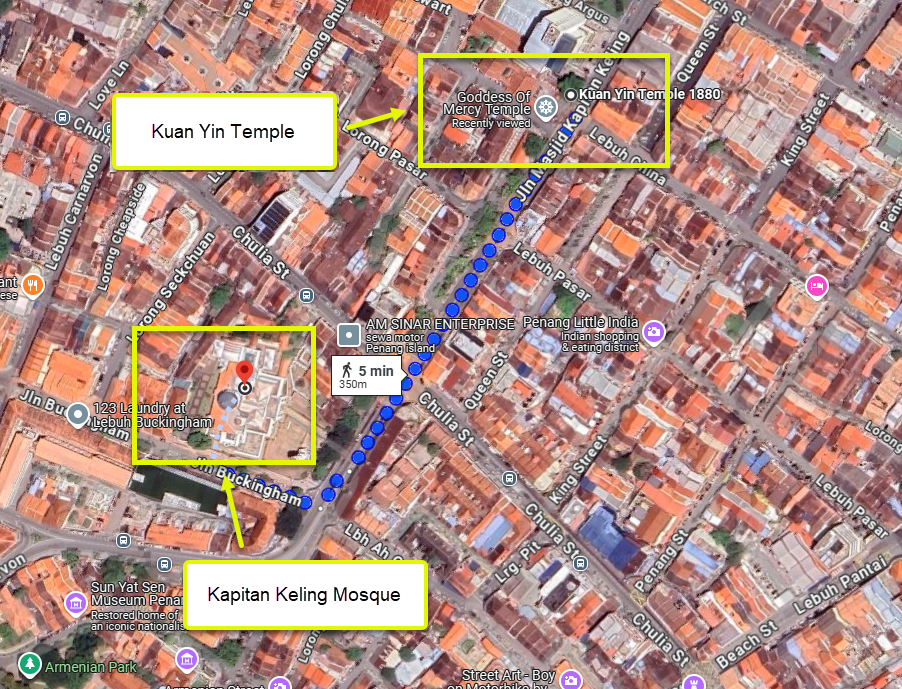
Little India
A bustling area filled with vibrant shops, delicious Indian food, and cultural festivities.
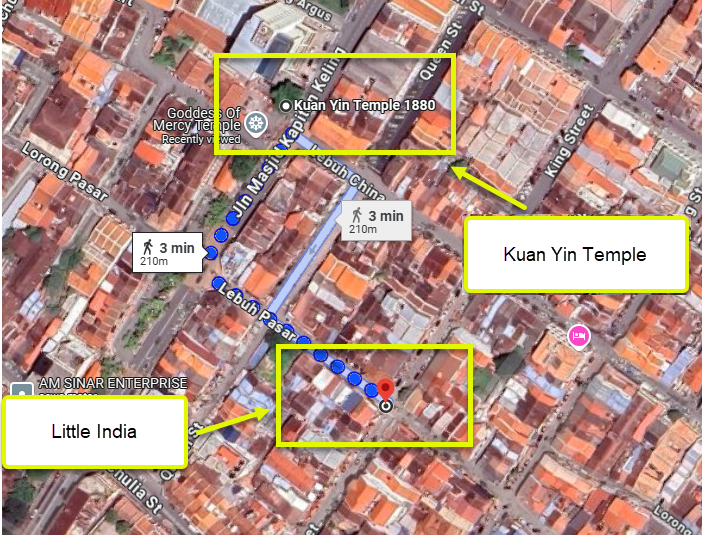
References
- “Goddess of Mercy Temple”, Wikipedia, last edited 21st October 2024, wikipedia.org ↩︎
- “Footprint Temple”, My-Island-Penang, my-island-penang.com ↩︎
- “Temple was originally for deity of seafarers Ma Chor Po”, The Star, thestar.com.my ↩︎
